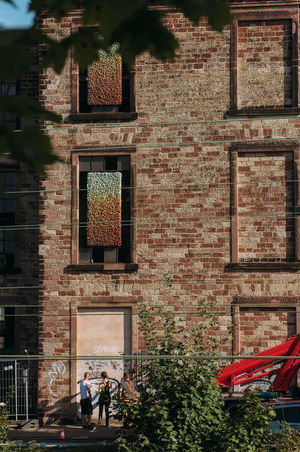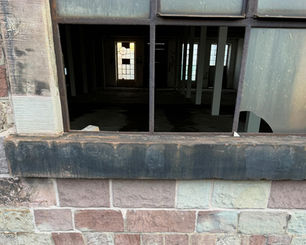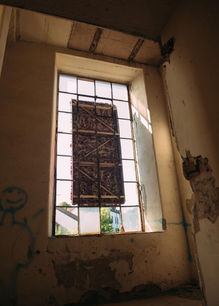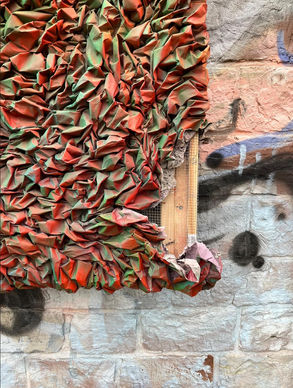
Konzept und Inspiration
„Temporäre Dauerhaftigkeit“ ist mehr als eine Installation – es ist ein Dialog mit Zeit, Raum und Erinnerung. Inspiriert von Künstlern wie El Anatsui, Christo und Jeanne-Claude, Richard Serra und Katharina Grosse, beschäftigt sich dieses Werk mit der architektonischen und historischen Erzählung der Baumwollspinnerei in Sankt Ingbert, Saarland. Diese Künstler, die für ihren transformativen Umgang mit Materialien und Raum bekannt sind, haben diese Installation inspiriert, um Ihre Wahrnehmung von Beständigkeit in Kunst und Architektur herauszufordern.
El Anatsuis Integration von Kunst in historische Umgebungen, Christo und Jeanne-Claudes dramatische Transformationen öffentlicher Räume und Richard Serras Interaktionen mit vertrauten Umgebungen haben alle dieses Werk beeinflusst. Serras „Tilted Arc“ forderte die Menschen heraus, Kunst in ihrem täglichen Erleben zu konfrontieren – ein Effekt, den ich hier nachbilden möchte. Die massive Sandsteinfassade des Gebäudes dient als Leinwand für ein Gespräch zwischen Vergangenheit und Gegenwart, Beständigkeit und Vergänglichkeit, Schöpfung und Verfall.

TATE. Richard Serra, Tilted Arc 1981. View of Federal Plaza with Tilted Arc seen from the side, Photograph by Susan Swider. Courtesy of Richard Serra [online] At: https://www.tate.org.uk/art/artists/richard-serra-1923/lost-art-richard-serra (Accessed 26.08.2024)
Der historische Kontext
Die 1885 erbaute Baumwollspinnerei steht als Zeugnis des industriellen Fortschritts, zunächst als Textilfabrik zur Produktion feiner Baumwollgarne und später als Bundeswehr-Sanitätsdepot. Heute bleibt sie ein Denkmal einer Ära des Funktionalismus, ihre Sandsteinfassade ein Relikt vergangener Zeiten.

Doch während Sanierungsprojekte kommen und gehen, symbolisiert das Gebäude selbst den fragilen Zustand des historischen Gedächtnisses – ständig debattiert, doch immer in Gefahr, vergessen zu werden.
Diese Installation bringt diesen Dialog in die Gegenwart, indem sie recycelte Zeitungen als Hauptmaterial verwendet. Zeitungen, wie das Gebäude selbst, sind vergänglich – sie tragen Nachrichten, die schnell veralten. Indem diese vergänglichen Materialien im Kontext einer historischen Struktur platziert werden, hinterfragt „Temporäre Dauerhaftigkeit“, was wir entscheiden, zu erinnern, und was wir erlauben, in Vergessenheit zu geraten.
Die Installation: Eine Metapher in Bewegung
Die Installation besteht aus sechs großen Tafeln, die aus geschichteten, recycelten Zeitungen gefertigt und sorgfältig über die Fenster der Baumwollspinnerei gelegt wurden. Diese Tafeln sind mehr als nur visuelle Elemente – sie sind eine Metapher dafür, wie Medien unsere Wahrnehmung verschleiern, unser Verständnis einschränken und unser kollektives Gedächtnis beeinflussen können.
Jede Tafel ist mit einem dualen Farbschema gestaltet – Rot-Orange auf der einen Seite und Grün-Gelb auf der anderen – was ein dynamisches Wechselspiel erzeugt, während Sie sich um das Gebäude bewegen. Diese wechselnde Farbpalette erinnert daran, dass Perspektive relativ ist und dass das vollständige Verständnis einer Situation erfordert, sie aus mehreren Blickwinkeln zu betrachten.
Materialien und Techniken
Die Tafeln bestehen aus recycelten Zeitungen, Holzrahmen und einem Metallgitter. Die Zeitungen wurden bemalt, jedoch nicht behandelt oder verändert, um der Natur oder menschlichen Einflüssen zu widerstehen. Diese bewusste Entscheidung betont die fragile und vorübergehende Natur der Installation und spiegelt die Vergänglichkeit der Materialien sowie der Geschichte, der Unbeständigkeit und der Flüchtigkeit menschlicher Bemühungen wider.

Jede Tafel ist nicht nur eine visuelle Aussage, sondern auch das Ergebnis repetitiver, körperlich anspruchsvoller Arbeit. Dies spiegelt die Geschichte des Gebäudes wider – einst ein Zentrum industrieller Aktivität, heute ein Relikt der Vergangenheit. So wie das Gebäude seinen ursprünglichen Zweck überlebt hat, werden diese Tafeln nur vorübergehend existieren und als Erinnerung an die Vergänglichkeit aller von Menschenhand geschaffenen Dinge verblassen.
Interagieren Sie mit der Kunst
Während Sie sich mit „Temporäre Dauerhaftigkeit“ beschäftigen, überlegen Sie, wie Ihre Reise Ihre Wahrnehmung formt. Die Farben, die Sie sehen, hängen von Ihrem Blickwinkel, Ihrer Geschwindigkeit und Ihrer Perspektive ab. Ebenso wie die Geschichte des Gebäudes, die offen für Interpretation und Diskussion ist, fordert die Installation Sie auf, zu hinterfragen, was nach dem Wandel bleibt und was im Prozess verloren geht.

Ihre Perspektive zählt – das Farbspektrum, das Sie erleben, wird durch Ihre einzigartige Reise geprägt. Welche Farben sehen Sie? Wie verändert Ihr Blickwinkel den Farbton?
Über die Künstlerin
Meine Arbeit erforscht häufig die Schnittstelle zwischen physischen und digitalen Realitäten, mit einem Fokus auf Themen wie Zeitlichkeit, Wahrnehmung und gesellschaftlichen Wandel. In „Temporäre Dauerhaftigkeit“ werden diese Themen durch das Prisma von Geschichte und Erinnerung zum Leben erweckt. Die Baumwollspinnerei, mit ihrer reichen Vergangenheit und neuen Zukunft, dient als perfekte Kulisse für diese Erforschung dessen, was es bedeutet, sich zu erinnern, zu vergessen und voranzuschreiten.

Diese Installation ist zutiefst persönlich, verbunden mit meiner eigenen Geschichte durch die nahe gelegene Wittemannstraße in St. Ingbert, benannt nach den Vorfahren meines Mannes, die Baumeister in St. Ingbert waren. Diese Verbindung fügt dem Thema „Temporäre Dauerhaftigkeit“ eine weitere Ebene hinzu und reflektiert über die Vergänglichkeit der Erinnerung und das verblassende Erbe jener, die einst unsere Welt gestalteten.
Dauer und Interaktion
Die Installation wird bis Ende Oktober bestehen bleiben. Sollte etwas die Tafeln verändern, werden diese Veränderungen als Teil des Werks angenommen – ein Spiegelbild der unvorhersehbaren Natur des öffentlichen Gedächtnisses und des gesellschaftlichen Wandels.
Vielen Dank für Ihren Besuch bei „Temporäre Dauerhaftigkeit“. Wenn Sie gehen, denken Sie an die Farben, die Sie gesehen haben, an die Perspektiven, die Sie erlebt haben, und daran, wie diese Erfahrung Ihre Sicht auf die Welt um Sie herum verändern könnte.
Bleiben Sie verbunden
Für weitere Informationen besuchen Sie https://www.instagram.com/wittemannmarina
Teilen Sie Ihre Erfahrungen mit #TemporaryPermanence
Künstlerin
Marina Wittemann
Temporary Permanence
Welcome to "Temporary Permanence," an installation that invites you to explore the delicate balance between the ephemeral and the enduring.
Concept and Inspiration
"Temporary Permanence" is more than an installation—it's a dialogue with time, space, and memory. Drawing from the work of influential artists like El Anatsui, Christo and Jeanne-Claude, Richard Serra, and Katharina Grosse, this piece engages with the architectural and historical narrative of the Baumwollspinnerei in Sankt Ingbert, Saarland in Germany. These artists, known for their transformative use of materials and space, have inspired this installation to challenge your perception of permanence in both art and architecture.
El Anatsui's integration of art within historical settings, Christo and Jeanne-Claude's dramatic transformations of public spaces, and Richard Serra’s interaction with familiar environments have all informed this work. Serra’s "Tilted Arc" challenged people to confront art within their daily experience, an effect I strive to replicate here. The building's massive brick façade serves as a canvas for a conversation between past and present, permanence and transience, creation and decay.

TATE. Richard Serra, Tilted Arc 1981. View of Federal Plaza with Tilted Arc seen from the side, Photograph by Susan Swider. Courtesy of Richard Serra [online] At: https://www.tate.org.uk/art/artists/richard-serra-1923/lost-art-richard-serra (Accessed 26.08.2024)
The Historical Context
The Baumwollspinnerei, built in 1885, has stood as a testament to industrial progress, first as a textile factory producing fine cotton yarns and later as a Bundeswehr medical depot. (Baumwollspinnerei mit Vernunft [online] At: https://www.st-ingbert.de/bauen-planung/projekte/alte-baumwollspinnerei/ (Accessed 23.08.2024)

Today, it remains a monument to an era of functionalism, its brick façade a relic of a bygone time. Yet, as redevelopment projects come and go, the building itself symbolizes the fragile state of historical memory—constantly debated, yet always at risk of being forgotten.
This installation brings this dialogue into the present, using recycled newspapers as the primary material. Newspapers, like the building, are transient—bearing news that quickly becomes outdated. By placing these ephemeral materials within the context of a historical structure, "Temporary Permanence" questions what we choose to remember and what we allow to fade into obscurity.
The Installation: A Metaphor in Motion
The installation features six large panels made of layered, recycled newspapers, carefully placed over the windows of the Baumwollspinnerei. These panels are more than just visual elements—they are a metaphor for how media can obscure our perception, limit our understanding, and influence our collective memory.

Each panel is designed with a dual colour scheme—red-orange on one side and green-yellow on the other - creating a dynamic interplay as you move around the building. This shifting colour palette is a reminder that perspective is relative and that understanding any situation fully requires viewing it from multiple angles. As you walk, drive, or ride past the installation, you’ll notice the colours change, inviting you to reconsider your surroundings and the narratives embedded within them.
The Materials and Techniques
The panels are constructed using recycled newspapers, wood frames, and a metal grid. The newspapers were painted but they have not been treated or altered to resist the nature or human impact. This deliberate choice emphasizes the fragile and temporary nature of the installation, mirroring the ephemerality of both the materials and the history, impermanence, and the transient nature of human efforts.

Each panel is not just a visual statement but a product of repetitive, physically demanding labor. This reflects the building's own history—once a hub of industrial activity, now a relic of the past. Just as the building has outlived its original purpose, these panels will exist only temporarily, fading away as a reminder of the fleeting nature of all things created by human hands.
Engage with the Art
As you engage with "Temporary Permanence," consider how your journey shapes your perception. The colours you see depend on your angle, your speed, and your perspective. Much like the building’s history, which is open to interpretation and debate, the installation asks you to question what remains after change and what is lost in the process.

Your Perspective Matters—the spectrum of colours you experience is shaped by your unique journey. What colours do you see? How does your view transform the hue?
About the Artist
My work often explores the intersection of physical and digital realities, with a focus on themes of temporality, perception, and societal change. In "Temporary Permanence," these themes are brought to life through the lens of history and memory. The Baumwollspinnerei, with its rich past and new future, serves as the perfect backdrop for this exploration of what it means to remember, to forget, and to move forward.
This installation is deeply personal, connected to my own history through the Baumwollspinnerei’s close location on Wittemann Street in St. Ingbert, named after my husband’s ancestors who were builders in St. Ingbert. This connection adds another layer to the theme of "Temporary Permanence," reflecting on the impermanence of memory and the fading legacy of those who once shaped our world.
Duration and Interaction
The installation will remain in place until the end of October. If vandalism or natural forces alter the panels, these changes will be embraced as part of the work—mirroring the unpredictable nature of public memory and societal change.
Thank you for visiting "Temporary Permanence." As you leave, consider the colours you’ve seen, the perspectives you’ve encountered, and how this experience might change your view of the world around you.
Stay Connected
For more information, visit https://www.instagram.com/wittemannmarina
Share your experience using #TemporaryPermanence
Artist
Marina Wittemann
Reflections
The presented installation lasted from August 29 to October 24, 2024.

Street Encounter
When I first installed Temporary Permanence in the Baumwollspinnerei in St. Ingbert, I didn’t expect how much people would engage with it. My focus was on fragility, memory, and what remains, expressed through six large newspaper panels placed in a raw urban space. But something unexpected happened: people stopped. Some even parked their cars, got out, and walked around, trying to see the changing colours. This spontaneous interaction made me realise how public space can activate an artwork beyond what I imagined. It became not just an installation, but a shared moment.

Personal Encounter
Working on Temporary Permanence taught me several important lessons:
-
Dream big, but stay grounded: Bold visions are essential, but true growth comes from reflecting and daring to try something new - not just repeating what has worked before.
-
Work hard – art isn’t for the lazy: If you love it deeply, even the hardest work becomes meaningful.
-
Create as if you’re showing at the biggest museum: While art starts from within, it’s completed by the viewer. Sharing it with others raises the bar and brings purpose.
-
Reflect deeply: Reflection helps you stay connected to your vision and learn from each project.
-
Value the process over the result: The emotional rollercoaster of creating the work (building, thinking, struggling) is the real treasure. Once the panels were up, I actually felt empty. The process had ended. The journey, not the result, holds the deepest meaning.
-
Don’t take yourself too seriously: Out of 8.2 billion people, everyone creates - food, ideas, children, love, war, objects, art... What sets you apart isn’t being “the best,” but your willingness to keep going.
-
Happiness comes through others: People are a miracle. We’re capable of both beauty and destruction, but real change and real art happen when we do something good together.
Photography: Galya Romaniuk


Nature and Vandalism as Response
The panels were exposed to wind and rain. They carry marks of time, fragility, and vulnerability.

But it wasn’t only nature that left a trace - human hands did too, and even if time with nature erases everything, human aggression accelerates this process.
A section of one panel was ripped; another was nearly torn from the wall. At first, I felt hurt. But then I realised: even destruction is a response. It means the work touched something.
Vandalism became a part of the artwork - a confrontation, a form of resonance. It highlighted how fragility and destruction live side by side, not only in material but also in our social spaces.

Resonance in the Gallery
Later, Temporary Permanence was shown in the exhibition Resonance at EXO Gallery in Stuttgart. This time, we restructured the panels into a semi-enclosed space. Faced outward, they revealed hidden newspaper layers through a metal grid. Visitors could enter and feel a quiet tension. Some described it as being both held and trapped.

In this new setting, the panels gained a different meaning. They spoke about containment and exposure, presence and isolation.
The sound-based practice of Valo Valentino added another layer. My panels, which absorb sound, stood in contrast to the way sound travels and leaves invisible imprints. Just like sound, ideas and emotions can resonate through us - sometimes seen, sometimes not. This echoed my ongoing research on media, propaganda, and violence. By bringing these panels into a protected gallery space, their message became sharper: once exposed, now sheltered, they represent the fragile balance between memory and forgetting, truth and manipulation, voice and silence.
The role of the artist in society
The torn newspapers and nearly destroyed panels have become symbols of a larger violence, not just against the artwork, but against the truths it tries to hold. In that sense, the vandalism wasn’t separate from the message; it was part of it.
My work reflects on the fragility of media and truth, especially in times of conflict.
-
The truth is often “ripped apart” or distorted.
-
The media is vulnerable to manipulation and destruction.
-
Readily available information is often attacked first.
-
Time erases everything; human aggression speeds up the process.
-
Scars of violence (physical or emotional) never fully fade.
-
Viewers are not just passive. They can either protect or destroy what they encounter.
Many thinkers have explored the destruction of beauty and meaning in art:
-
Jean Baudrillard saw vandalism as a rebellion against consumer culture and empty beauty.
-
Sigmund Freud believed in the "death drive", a compulsion to destroy what we can’t possess.
-
Theodor Adorno suggested that beauty can provoke violence if it feels disconnected from real life.
-
Immanuel Kant’s idea of the sublime, when beauty overwhelms us, might explain why some destroy what they cannot understand.
-
Artists like Banksy show how beauty is fragile and easily becomes a target for social or political anger.
Moving Forward: Art as a Tool for Change
I believe that art can do more than reflect society - it can help shape it. If we want to reduce acts of vandalism and aggression, I believe we can develop tools through art that invite reflection, empathy, and connection:
-
Aesthetic experience as emotional regulation: calm, harmonious colours and nature-inspired designs can reduce stress and aggression.
-
Empathy through art: art that tells human stories can help people connect and feel protective toward it.
-
Destruction as part of the artwork: sometimes, controlled destruction or interaction helps release tension rather than escalate it.
-
Public participation: when viewers help create or shape a work, they often feel responsible for it.
-
Ritual and sacredness: art that feels symbolic or sacred is less likely to be destroyed.
I hope to turn these ideas into a working tool - something that not only protects art, but brings people closer to it. A tool that helps us remember that what we choose to destroy or protect reveals who we are. This is my way of trying to make the world just a little bit better.


















































